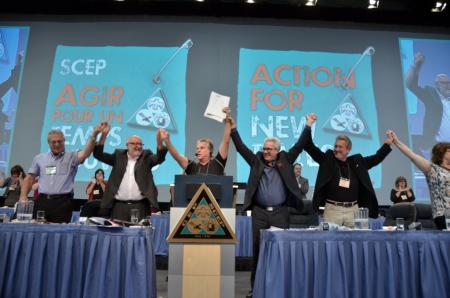When CAW President Ken Lewenza took the podium at the Communications, Energy, and Paperworkers (CEP) convention in Quebec City Monday morning, the 1,000-plus delegates knew they were about to hear why a merger between CEP and CAW makes sense. What delegates did not know was they were about to hear a trade unionist lay out the union movement creed — justice for workers — with enough power and conviction to convince any of those wondering how to vote on the merger to vote yes.
At the conclusion of his passionate account of what it means for workers to take on employers every day Lewenza brought out his wallet. “We all have too many cards,” he said, “including ones that get us into debt up to our butt. But there is one card that matters most to me.” Holding it high for all to see, Lewenza yelled out: “It’s my union card. Mine says CAW. But the important thing is, it’s a union card. It’s why I have a house, a car, and a job.”
The ensuing standing ovation was a pretty good signal that CEP was going to vote yes to the merger. Just after noon on Monday Oct. 15, CEP President Dave Coles announced the results: over 90 per cent of the delegates voted to merge with CAW. Appearing after at a press conference, Coles spoke of an historic occasion. By deciding to build a new union, the CEP convention was taking a step forward for progressive people in Canada.
CAW Secretary-Treasurer Peter Kennedy called it a “marriage of two hell-raisers, made in heaven.” Kennedy along with CEP Secretary-Treasurer Gaétan Ménard co-chaired the “proposal committee” formed by the two unions to formulate merger plans.
Approval of the merger by CEP followed earlier approval by the CAW Constitutional Convention. To make the new union a reality, six working groups are being established to work out the practical questions that need answers. The new union needs a constitution, to make staffing decisions, a headquarters and regional offices, an organization chart and a plan for organizing new workers, a visual identity (new name and logo), and to plan a founding convention (expected for the summer or fall of 2013).
What gets agreed by the six committees will still have to be ratified by both the existing unions before the new union comes into existence at its founding convention.
The two bodies have important similarities. Each of them have recognized that Quebec has a national character, and needs autonomy within the union. Establishing a strong Quebec presence on the basis of an “associated sovereignty” will happen in the new union.
New Democrats will be watching the political orientation of the new union closely. CEP is affiliated with the NDP; currently the CAW is not. The Quebec wing of the CAW makes its own election strategy. Presumably the Quebec wing of the new union will be deciding whether to back the NDP or the Bloc in the next federal election expected in 2015.
The new union will be built on the over 950 local unions from the two organizations, and those locals will continue to exist within the new union. Both unions service local unions from diverse industries. The new union will have industry councils so as to facilitate pattern bargaining with various companies within each industry.
Proponents of the new union know what is going wrong today. As Kennedy put it, neo-liberalism is not working for the 99 per cent. Dave Coles talked about how decency is disappearing and Canadians suffer as big government and big business work together against the interests of working people.
What is going to be tested in the next months is the ability to deliver on the promise that creating a new union, over 300,000 strong, will make things better for its members, and have the kind of impact on the politics of the country that proponents of the merger want to see.
Ken Lewenza and Dave Coles were clear. They want to build a new union so that Canada can become a different country, one where working people are respected, and the most vulnerable among us protected.
Duncan Cameron is the president of rabble.ca and writes a weekly column on politics and current affairs.



